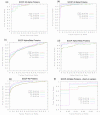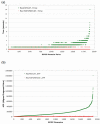TOPS++FATCAT: fast flexible structural alignment using constraints derived from TOPS+ Strings Model
- PMID: 18759993
- PMCID: PMC2553092
- DOI: 10.1186/1471-2105-9-358
TOPS++FATCAT: fast flexible structural alignment using constraints derived from TOPS+ Strings Model
Abstract
Background: Protein structure analysis and comparison are major challenges in structural bioinformatics. Despite the existence of many tools and algorithms, very few of them have managed to capture the intuitive understanding of protein structures developed in structural biology, especially in the context of rapid database searches. Such intuitions could help speed up similarity searches and make it easier to understand the results of such analyses.
Results: We developed a TOPS++FATCAT algorithm that uses an intuitive description of the proteins' structures as captured in the popular TOPS diagrams to limit the search space of the aligned fragment pairs (AFPs) in the flexible alignment of protein structures performed by the FATCAT algorithm. The TOPS++FATCAT algorithm is faster than FATCAT by more than an order of magnitude with a minimal cost in classification and alignment accuracy. For beta-rich proteins its accuracy is better than FATCAT, because the TOPS+ strings models contains important information of the parallel and anti-parallel hydrogen-bond patterns between the beta-strand SSEs (Secondary Structural Elements). We show that the TOPS++FATCAT errors, rare as they are, can be clearly linked to oversimplifications of the TOPS diagrams and can be corrected by the development of more precise secondary structure element definitions.
Software availability: The benchmark analysis results and the compressed archive of the TOPS++FATCAT program for Linux platform can be downloaded from the following web site: http://fatcat.burnham.org/TOPS/ CONCLUSION: TOPS++FATCAT provides FATCAT accuracy and insights into protein structural changes at a speed comparable to sequence alignments, opening up a possibility of interactive protein structure similarity searches.
Figures








References
-
- Murzin AG, Brenner SE, Hubbard TJP, Chothia C. SCOP: a structural classification of proteins database for the investigation of sequences and structures. Journal of Molecular Biology. 1995;247:536–540. - PubMed
-
- Ye Y, Godzik A. Flexible structure alignment by chaining aligned fragment pairs allowing twists. Bioinformatics. 2003;19 Suppl 2:II246–II255. - PubMed

